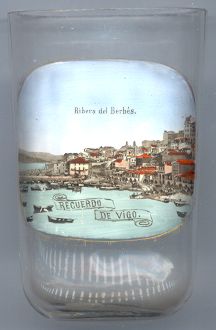

|
| ESPAÑA | Spain |
| Galicia | |
| Provincia de Pontevedra |
 Vigo is an important port town at the Ría de Vigo at the Atlantic Ocean in the Pontevedra province
of the autonomous region Galicia in the northwest of Spain.
Vigo has one of the largest natural ports of Spain and harbours Europe's largest fishing fleet.
Vigo is an important port town at the Ría de Vigo at the Atlantic Ocean in the Pontevedra province
of the autonomous region Galicia in the northwest of Spain.
Vigo has one of the largest natural ports of Spain and harbours Europe's largest fishing fleet.
Vigo goes back to a Roman settlement, a 'vicus', which also is the origin of the town's name. It is assumed that this place was the base for Julius Caesar's conquest of Britain. The medieval settlement was located at the foot of the mountain Castro and included the present old town district of Berbés. At the end of the 10th century Vigo was destroyed by the Moors and could only be repopulated in 1170 by Fernando II, King of Galicia, León and Asturia. During the 14th century raiding troops of Normans and the Plague decimated the town's population. Vigo started to flourish again after important privileges were granted by Emperor Charles V in 1529. Especially important for Vigo was the trade with South America. As the town was not fortified, it was easy for Sir Francis Drake to completely destroy Vigo in 1589. The town received fortifications only after Turkish pirates had looted the area of the Ría de Vigo in 1619. After a sea battle between the Spanish-French armada and English and Dutch fleets in 1702, the victorious English raided Vigo. French troops occupied Vigo in 1808, but were driven out by the citizens already three months later. In 1840 only about 5,500 inhabitants had been left. The Faro de Vigo, one of the oldest newspapers of Spain, was first published in 1853. During the 19th and 20th century the fishing industry became the basis for a rapid and vigorous growth of the town. 1959, the diocese of Tui was renamed Tui-Vigo, with the church of Santa Maria since then being the co-cathedral of the diocese, which is one of the four suffragan dioceses of the archdiocese of Santiago de Compostela. As of the 2003 census, the population of Vigo city was over 292,000; the population of the entire urban area is estimated to be about 420,000.
The picture on glass no. 1916 [left] shows the
 Ribera
Ribera
![[scale]](lineal.jpg)